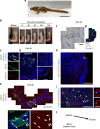A developmentally regulated switch from stem cells to dedifferentiation for limb muscle regeneration in newts
- PMID: 27026263
- PMCID: PMC4820895
- DOI: 10.1038/ncomms11069
A developmentally regulated switch from stem cells to dedifferentiation for limb muscle regeneration in newts
Abstract
The newt, a urodele amphibian, is able to repeatedly regenerate its limbs throughout its lifespan, whereas other amphibians deteriorate or lose their ability to regenerate limbs after metamorphosis. It remains to be determined whether such an exceptional ability of the newt is either attributed to a strategy, which controls regeneration in larvae, or on a novel one invented by the newt after metamorphosis. Here we report that the newt switches the cellular mechanism for limb regeneration from a stem/progenitor-based mechanism (larval mode) to a dedifferentiation-based one (adult mode) as it transits beyond metamorphosis. We demonstrate that larval newts use stem/progenitor cells such as satellite cells for new muscle in a regenerated limb, whereas metamorphosed newts recruit muscle fibre cells in the stump for the same purpose. We conclude that the newt has evolved novel strategies to secure its regenerative ability of the limbs after metamorphosis.
Figures




References
-
- Tsonis P. A. Limb Regeneration Cambridge Univ. Press (1996) .
-
- Sandoval-Guzmán T. et al. Fundamental differences in dedifferentiation and stem cell recruitment during skeletal muscle regeneration in two salamander species. Cell Stem Cell 14, 174–187 (2014) . - PubMed
-
- Casco-Robles M. M. et al. Expressing exogenous genes in newts by transgenesis. Nat. Protoc. 6, 600–608 (2011) . - PubMed
-
- Holder N. Organization of connective tissue patterns by dermal fibroblasts in the regenerating axolotl limb. Development 105, 585–593 (1989) . - PubMed
-
- Feil R., Wagner J., Metzger D. & Chambon P. Regulation of Cre recombinase activity by mutated estrogen receptor ligand-binding domains. Biochem. Biophys. Res. Commun. 237, 752–757 (1997) . - PubMed
Publication types
MeSH terms
Substances
Grants and funding
LinkOut - more resources
Full Text Sources
Other Literature Sources
Medical
Molecular Biology Databases
Research Materials

